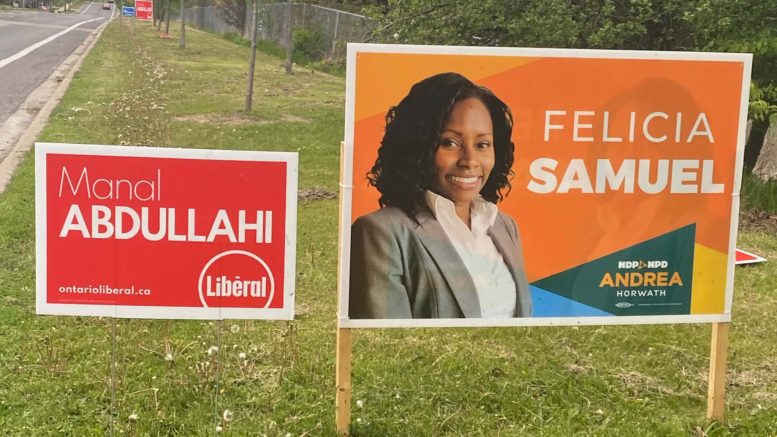As election pressure intensifies in Toronto’s east end, many voters are experiencing feelings of overload and perplexity given the extent of similarities between the Liberal party and the New Democratic Party (NDP).
Though both leaders have not yet ruled out working together, they pledge not to support Doug Ford if a Conservative minority government is formed.
What are the similarities between these two parties?
Reducing class sizes and hiring more teachers is a key priority for both the Liberals and the NDP.
According to NDP Leader Andrea Horwath, time is up when it comes to the Liberal platform on education reform.
“No matter what Steven Del Duca says now, he had 15 years to make sure we had smaller class sizes, and the Liberals refused to do it,” she told reporters at Queen’s Park in Toronto earlier this month.
Aside from education, both sides are planning to cancel the development of Highway 413, the new 59- km highway which the Conservative party is promising to build if elected. The highway would connect Milton and Vaughan.
Both parties plan to offer rebates to buyers of electric vehicles and want to reduce greenhouse gas emissions by 50 per cent.
Finally, both the Liberals and NDP want to put an end to for-profit long-term care homes in Ontario.
What are the differences?
While the priorities of the NDP and Liberal platforms do appear to have many similarities, both parties do have notable differences.
Among their shared education promises, the Liberal party plans to bring back Grade 13, double OSAP funding and commit $10 billion towards repairing schools. Earlier this month, Howarth announced her party’s promise to invest $5 billion within the first three years towards repairing schools.
In terms of affordability and jobs, the provincial minimum wage has been a topic of discussion for much of this election. While the Liberals plan to raise wages to $16, the NDP has outlined their pledge to increase the minimum to $20 per hour before 2026. This would begin with a $1 increase by October 2022.
Along the campaign trail this month, voters across the province have expressed much concern about housing.
From exclusionary zoning, implementing rent control and eliminating financial incentives for landlords looking to increase fees, the NDP’s plan for the current housing problem is to introduce more regulation.
Horwath and her team are planning to build 100,000 new social housing units and 60,000 new supportive units. The NDP also want to create a portable housing benefit that provides subsidies for 311,000 homes.
Liberal Leader Del Duca is pledging to build 1.5 million new homes over the next 10 years, including 138,000 affordable homes.
The ongoing problem of empty homes in the province is also an issue the Liberals plan to address by implementing an empty homes tax of five per cent on non-Canadian owners and two per cent on Canadian owners.
How does this affect Scarborough?
Recently, the Toronto Observer caught up with Scarborough-Rouge Park NDP candidate Felicia Samuel and we asked her what sets her party apart from the Liberals.

“The fact that the Liberals have had over 15 years of power and they did not deliver,” Samuel said in an interview. “Del Duca was in office with Kathleen Wynne, it’s not like this is some new fresh guy — he was there the whole time.”
Samuel added that above all else in the pandemic, Scarborough suffered the most.
“It blows my mind that people would even support this guy. We all lost under Doug Ford’s leadership,” Samuel said.
Even during the worst of COVID-19, Samuel states that the Scarborough Health Network had a great campaign. Unfortunately, when it came to funding, Samuel says the efforts made by the Conservative government were insufficient.
“They shouldn’t have to be raising money for equipment. That’s the work of the government.”
Toronto Observer reached out to Scarborough–Rouge Park Liberal candidate Manal Abdullahi by phone and social media; her team declined comment.
What do experts think?
Nelson Wiseman is a political science professor from the University of Toronto with a demonstrated expertise in provincial politics and elections.
Wiseman says both parties are critical of the Ford government. He said if a minority Conservative government is formed, it’s possible to expect an accord formed by the Liberals and NDP — similar to what we’ve seen this year at the federal level.
“People will be voting on a general sense of how they feel, their images of the leaders, and how well off they are now.” Wiseman said in an interview.
Randy Besco is an assistant professor in the University of Toronto Mississauga’s political science department. Besco tells reporters that the decision between the Liberals and NDP is based on competence and honesty.
“Liberals and NDP tend to dislike the PCs a lot, but not each other as much,” said Besco. “Political scientists call this negative partisanship. That makes Liberal/NDP switching easier.”
This is a corrected story. A previous version misspelled Felicia Samuel’s last name.


